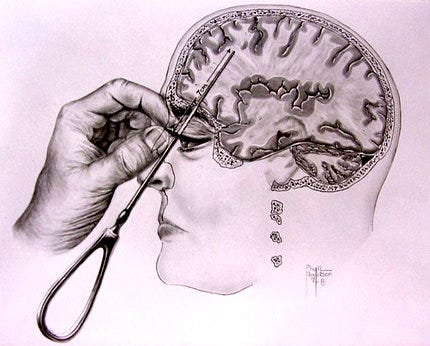Lobotomy: A Historical Overview of Its Controversial Legacy
Written on
Chapter 1: The Early Foundations of Brain Anatomy
In 1796, François Joseph Gall (1758-1828), a German physician, developed a keen interest in the structure of the brain. He posited that different intellectual abilities corresponded to specific protrusions on the brain's surface. Over time, it became evident that while his observations were not entirely incorrect, the simplistic nature of these "bumps" was misleading. It was later discovered that certain areas of the brain do indeed relate to distinct mental functions, though not in the way Gall suggested.
He identified various cerebral regions, such as one linked to the "need for goodness," another to "greed," and others associated with "aesthetic perception" and "admiration." After relocating to France, Gall continued his research and co-published several influential works with Johann Spurzheim (1776-1832), including "Anatomy and Physiology of the Nervous System in General and the Brain in Particular" in 1810, followed by a second volume in 1812. They also released "Observations on Phrenology," a term Gall coined, which was premature given the limited anatomical knowledge of their time.
Despite his enthusiasm, Gall's theories were largely speculative and lacked empirical support. His notion of intellectual "bumps" resembled earlier ideas such as Hippocrates' four humors and Paracelsus' principles. After parting ways with Gall in 1812, Spurzheim traveled to England and the United States, where he continued to promote phrenology, publishing significant works like "A View of the Philosophical Principles of Phrenology" in 1825.
A more cautious approach to brain anatomy was taken by François Leuret (1797-1851) and Louis P. Gratiolet (1815-1865), who published "Anatomie comparée du système nerveux considéré dans ses rapports avec l’intelligence" in 1839, offering a more measured perspective. In 1854, Gratiolet published "Mémoires sur les plis cérébraux de l’homme et des primates," enhancing the understanding of brain structure and distinguishing the four lobes of the cerebral hemispheres: frontal, temporal, parietal, and occipital. This classification remains fundamental in modern neuroscience.

Chapter 2: The Rise of Lobotomy in Modern Medicine
In 1935, the practice of "prefrontal leucotomy" was pioneered by Antonio Egas Moniz (1874-1955) and Almeida Lima (1903-1985) in Portugal, targeting mentally ill patients in an attempt to alleviate their conditions. This technique, tested on chimpanzees, involved surgical intervention in the frontal lobe, with the belief that altering brain structure could restore mental health. Moniz's subsequent publications, including "Operative Attempts in the Treatment of Certain Psychoses" (1936) and "Prefrontal Leucotomy: Surgical Treatment of Certain Psychoses" (1937), laid the foundation for lobotomy as a treatment for severe mental disorders, earning him a Nobel Prize in Medicine in 1949.
In 1936, American doctors Walter Freeman (1895-1972) and James W. Watts (1904-1994) introduced the term "lobotomy" to describe their more radical approach to brain surgery. Their method involved a more extensive destruction of white matter, which they believed could treat various mental illnesses. Initial outcomes were promising, leading to the widespread adoption of lobotomy procedures post-World War II, with Freeman reportedly performing around 3,500 operations.
The most well-known lobotomy patient was Rosemary Kennedy, sister to future President John F. Kennedy. Subjected to the procedure at 23, she remained institutionalized until her passing in 2005. Despite its popularity, lobotomy faced mounting criticism from the medical community, which argued that the extreme nature of the procedure outweighed its benefits, particularly the method of inserting instruments into the brain through the eyes.
By the mid-1950s, the enthusiasm for lobotomy began to diminish, coinciding with the introduction of psychotropic medications that offered a "chemical lobotomy" alternative. Today, lobotomy is rarely performed, reserved for only the most exceptional cases.
The concept of surgically intervening in the brain can be justified under certain circumstances, akin to operating on the heart for cardiac issues. While the technique was effective in some instances, the extensive application of lobotomy often lacked proper justification.
This documentary titled "The Dark side of Science: The Lobotomy, the worst surgery in history?" delves into the historical context and ethical implications of lobotomy as a medical practice.
The second video, "Lobotomy: A Dangerous Fad's Lingering Effect on Mental Illness Treatment | Retro Report," examines the lasting effects of lobotomy on mental health treatment and societal perceptions.